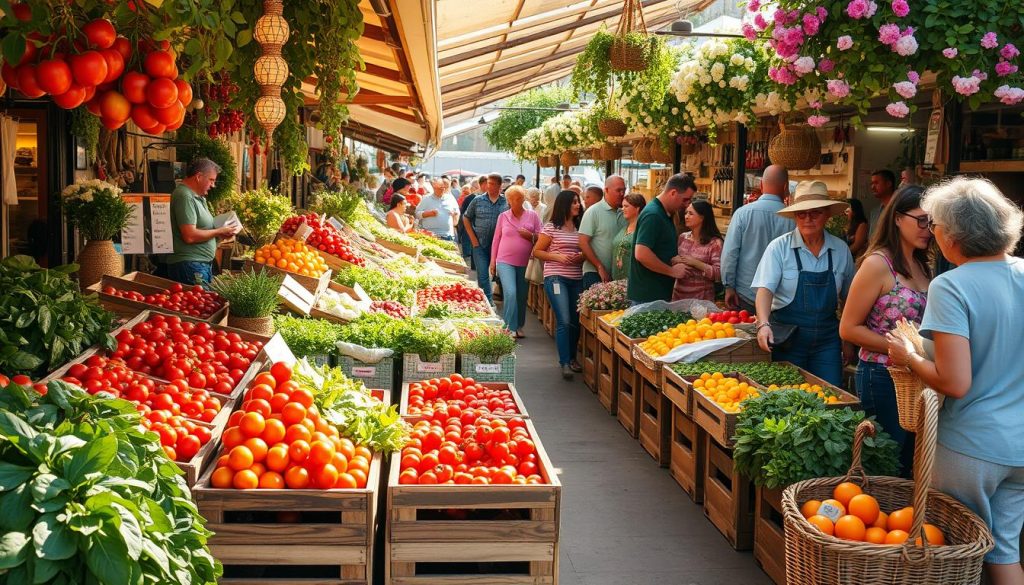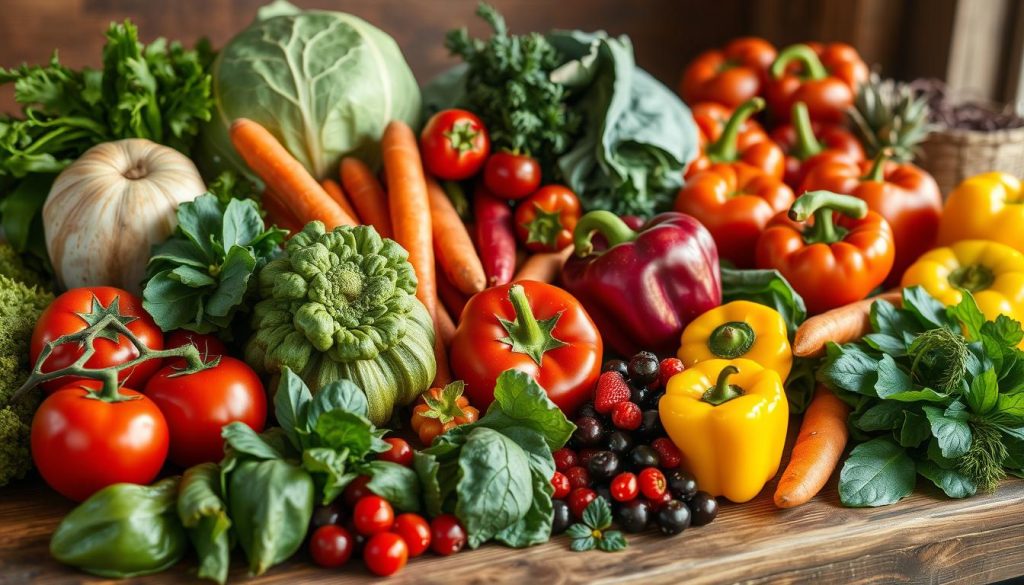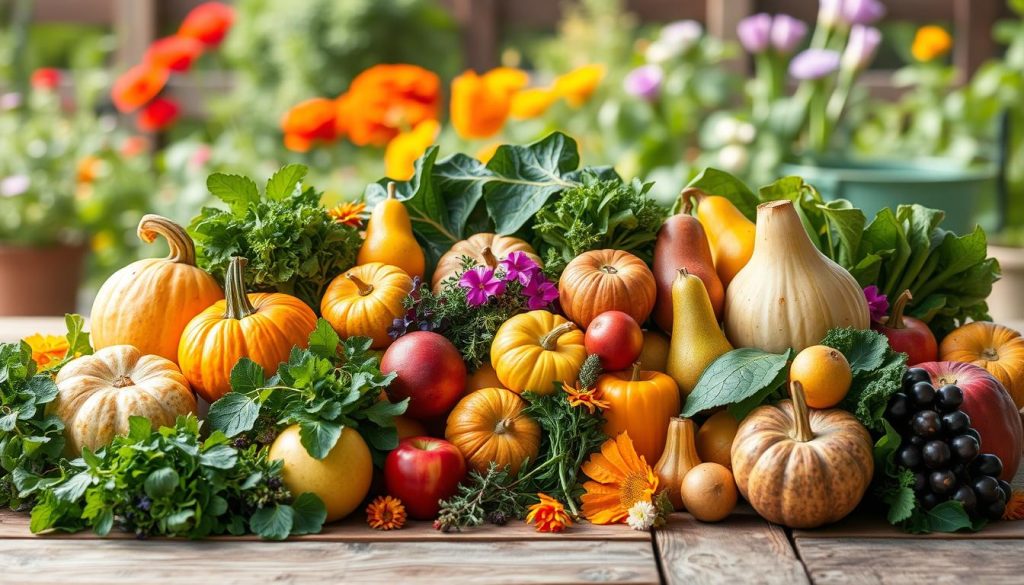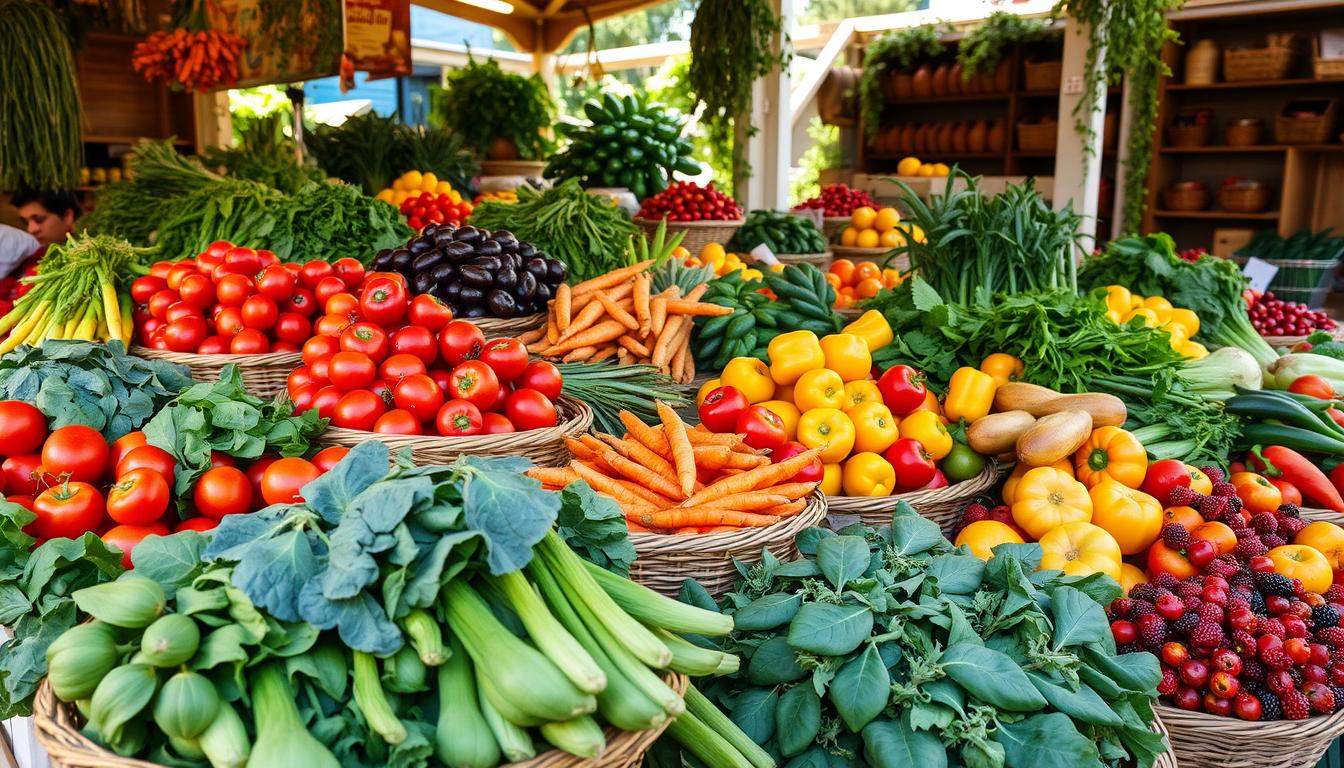As the seasons change, so does the harvest from nature. Eating seasonally can make your food taste better and improve your health. In this guide, I’ll show you how to add fresh, local produce to your meals. I’ll also give you tips to make seasonal eating a part of your life.
Eating seasonally means choosing foods that match the earth’s natural cycles. This gives you the best-tasting and most nutritious ingredients. By supporting local farms, you help the environment and enjoy food at its best. Let’s explore the benefits of seasonal eating together.
Understanding the Benefits of Seasonal Eating
Starting my wellness journey, I’ve learned a lot about seasonal eating. Choosing locally grown, seasonal produce gives me better taste and many health and environmental perks.
Why Choose Seasonal Produce?
Seasonal produce is picked at its best, offering the most flavor and nutrients. By picking in-season fruits and veggies, I help the environment and support local farmers. This cuts down on food miles and supports sustainable farming.
Nutritional Advantages of Fresh Ingredients
Seasonal, organic produce has more nutrients and is easier for our bodies to use. Eating fresh, local foods means my meals are full of vitamins, minerals, and antioxidants. This helps keep my body healthy and supports my wellbeing.
Environmental Impact of Seasonal Choices
Seasonal eating is good for me and the planet. It reduces food miles and supports local farmers. This helps lower carbon emissions and promotes a greener future.
Exploring seasonal eating, I’m looking forward to new tastes and health benefits. I’m also excited to help the environment and support sustainable farming.
How to Identify Seasonal Produce

Exploring fresh, seasonal produce is a fun journey. Learning to spot the best fruits and veggies each month lets you enjoy their peak flavors and health benefits. Joining a local farmers’ market or a community supported agriculture (CSA) program is a great way to get the season’s best.
Top Seasonal Fruits and Vegetables by Month
Seasonal produce changes by region, but here’s a basic guide to some common items:
- Spring (March-May): Asparagus, strawberries, peas, spinach, rhubarb
- Summer (June-August): Tomatoes, zucchini, corn, peaches, blueberries
- Fall (September-November): Apples, pumpkins, Brussels sprouts, sweet potatoes, broccoli
- Winter (December-February): Citrus fruits, Brussels sprouts, kale, root vegetables, winter squash
Local Farmers’ Markets and Their Offerings
Local farmers’ markets are great for finding seasonal produce and meeting local growers. These markets offer a variety of fresh ingredients, from juicy tomatoes to crisp greens. You can also find artisanal goods, baked items, and more, making them perfect for your seasonal shopping.
Another option is to join a CSA program. You’ll get a box of fresh, locally-grown produce every week or two. It’s a fantastic way to try new foods and add variety to your meals.
Simple Ways to Incorporate Seasonal Produce into My Meals
I’m always looking for new ways to add seasonal produce to my meals. Fresh, farm-to-table ingredients are available all year. They make my dishes delicious and help my local community and the planet.
Easy Recipe Ideas for Each Season
Summer is great for fresh recipes like grilled peach and burrata salad. Zucchini noodle stir-fry with fresh tomatoes is another favorite. In fall, I enjoy roasting butternut squash and apples for a cozy soup.
Winter brings hearty dishes like beef and barley stew with local root vegetables. Spring is all about light meals like asparagus frittata and strawberry spinach salad.
Meal Prep Tips for Seasonal Ingredients
- Visit farmers’ markets and local farms for the best produce.
- Roast, sauté, or blanch veggies to prep for the week.
- Freeze soups, stews, and sauces for later use.
- Can or freeze summer fruits and veggies to keep their flavor.
Seasonal recipes and meal prep make it easy to enjoy farm-fresh flavors every day. Eating seasonally nourishes my body and supports my community and the environment.
The Role of Seasonal Eating in My Wellness Journey

Starting a farm-to-table lifestyle and adding organic produce to my meals changed my life. Choosing seasonal, sustainable food has given me a diet full of variety and nutrients. It makes me feel good both physically and mentally.
Enhancing My Diet with Variety and Freshness
Eating with the seasons has shown me how much fresh, tasty food is out there. I now visit local farmers’ markets and farm-to-table stores. This way, I get to enjoy a wide range of delicious and healthy foods.
The Psychological Benefits of Eating Seasonally
Seasonal eating has also improved my mental health. It connects me to the earth and makes me appreciate my food more. This connection has made me feel less stressed and more at peace.
Seasonal eating has been a big win for my health and happiness. It’s helped me feel more alive and fulfilled. I’m grateful for the journey and the benefits it’s brought to my life.
Overcoming Challenges of Eating Seasonally

Eating seasonally is rewarding and healthy, but it comes with challenges. Finding seasonal food, especially in winter, can be tough. Yet, with creativity and resourcefulness, we can enjoy local and natural foods all year.
Finding Seasonal Options in Winter
Winter may seem like a time when fresh produce is scarce. But, there are many tasty and healthy options available. Root veggies like carrots and potatoes are common, along with greens like kale. Winter squash, like butternut, is also at its best.
Visiting local farmers markets or joining a CSA helps. These places offer fresh produce and support local farmers. I’ve found many winter veggies that are now part of my cooking.
Dealing with Limited Availability
- Preserve summer produce: I preserve summer fruits and veggies when they’re in season. This way, I can enjoy them in winter.
- Explore lesser-known winter veggies: I look for unique winter veggies like parsnips and rutabagas. They add variety to my meals.
- Get creative with meal planning: When some ingredients are hard to find, I try new recipes. This makes my meals more exciting.
Eating seasonally takes effort, but it’s worth it. It connects me to the food and the land. By embracing seasonal eating, I’ve grown closer to nature.
Embracing a Seasonal Mindset
Adopting a seasonal eating mindset can change your life. It helps you appreciate the natural cycles of food production. By eating with the seasons, you connect with your food and the environment.
Cultivating My Connection to Food and Nature
Seasonal eating has made me understand the seasons better. I look forward to fresh, local produce. Each season brings unique flavors and textures.
This connection to the land has made my cooking better. I appreciate sustainable agriculture and the farm-to-table movement more.
Encouraging Others to Join Me in Seasonal Eating
I love sharing seasonal eating with my loved ones. I talk about its health benefits, environmental impact, and joy. I want to inspire others to eat mindfully.
Together, we can support local farmers. We can promote sustainable agriculture. And we can appreciate the natural world that feeds us.

